The Orbit of Mars
This animation shows how Earth and Mars move around the Sun in their orbits.
 Click the "Play Fast" button in the lower left corner to make the planets move. For every second that goes by, the planets will move ahead one week's worth of time.
Click the "Play Fast" button in the lower left corner to make the planets move. For every second that goes by, the planets will move ahead one week's worth of time.
(Note: If you cannot see the animation below, or it is not working properly, you may need to download the latest Flash player.)
The other buttons make the planets move faster or slower, move backwards, or stop. The date in this simulation is shown above the buttons.
The "telescope view" in the upper left corner shows how big Mars looks from Earth through a telescope at a given time. The view only shows the size of Mars as viewed from Earth. It does not show how Mars changes in other ways over time, such as Mars spinning on its axis or the changing seasons on Mars.
Beneath the "telescope view" is a readout of the distance between Earth and Mars. Each time Earth passes close to Mars the event is called an "opposition". Notice how the size of Mars as seen through the telescope is not the same at every opposition. The orbit of Mars is not a circle; it is more of an oval in shape. Because an opposition can happen when Mars is at different points in its orbit, the distance at opposition changes, and so does the size of Mars as viewed from Earth. During the opposition in August 2003, Earth and Mars were closer together than they had been in thousands of years!
The red dot is Mars. Earth is blue, and the Sun is yellow. The locations of the planets are shown to scale, but their sizes are not (the planets are actually much, much smaller than the Sun).
You might also be interested in:
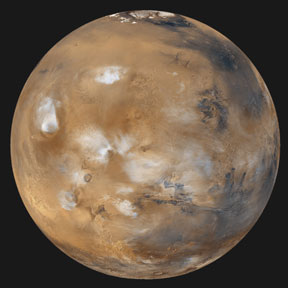
The planet Mars is closer to Earth than normal right now. On October 30, 2005, the two planets will be very close to each other. They will be about 69 million km (43 million miles) apart. Mars will look
...more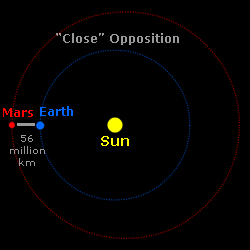
On August 27, 2003, Earth and Mars will be closer together than they have been in thousands of years. Mars will pass within 55,758,006 kilometers (34,646,418 miles) from Earth. Astronomers have calculated
...more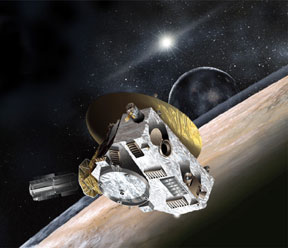
NASA is sending a spacecraft to Pluto. The spacecraft is named New Horizons. New Horizons, which is a robot, will be the first spacecraft to visit Pluto. New Horizons blasted off in January 2006. New Horizons
...more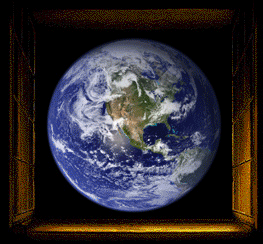
Here you will find links to all sorts of pictures, animations, videos, sounds, and interactive multimedia that are on Windows to the Universe Explore collections of images in the Image Galleries. Watch
...more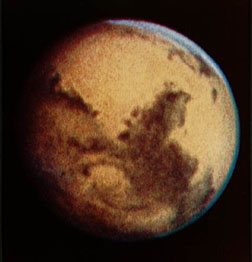
Mars is much like Venus-- it's very bright and therefore easily spotted in the night sky. Because of this, we don't know who exactly discovered Mars. We do know it was named after the Roman god of war,
...more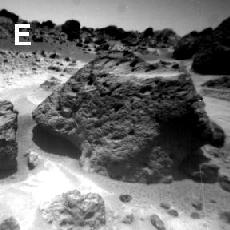
On Mars the surface winds accelerate to higher speeds than those on Earth. The general circulation pattern of winds is also very different from the terrestrial circulation pattern. These winds can be whipped
...more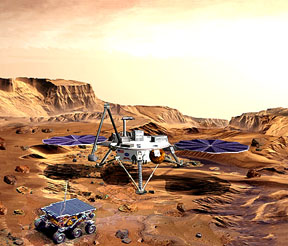
If approved, the Mars 2003 mission will have two important parts. The first is the Mars Surveyor 2003 Lander, which will be launched sometime between May 27, 2003, and June 17, 2003. The lander will use
...more
The Mars '98 lander was supposed to land in the south polar region of Mars. This image of layered terrain near the south pole was provided by the Mars Global Surveyor mission. In the image, ground fog
...more
![]() Click the "Play Fast" button in the lower left corner to make the planets move. For every second that goes by, the planets will move ahead one week's worth of time.
Click the "Play Fast" button in the lower left corner to make the planets move. For every second that goes by, the planets will move ahead one week's worth of time.













